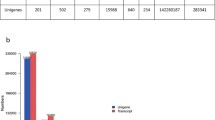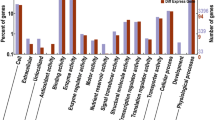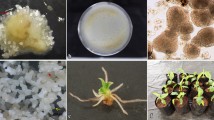Abstract
The molecular nature of gene expression during the initiation and progress of diplosporous apomixis is still unknown. Moreover, the basis of the close correlation between diplospory and polyploidy is not clarified yet. A comparative expression analysis was performed based on expressed sequence tags (ESTs) sequencing and differential display in an Eragrostis curvula diplosporous tetraploid genotype (T, 4x apo), a sexual diploid derivative obtained from tissue culture (D, 2x sex) and an artificial sexual tetraploid obtained from the diploid seeds after colchicine treatment (C, 4x sex). From a total of 8,884 unigenes sequenced from inflorescence-derived libraries, 112 (1.26%) showed significant differential expression in individuals with different ploidy level and/or variable reproductive mode. Independent comparisons between plants with different reproductive mode (same ploidy) or different ploidy level (same reproductive mode) allowed the identification of genes modulated in response to diplosporous development or polyploidization, respectively. Surprisingly, a group of genes (Group 3) were differentially expressed or silenced only in the 4x sex plant, presenting similar levels of expression in the 4x apo and the 2x sex genotypes. A group of randomly selected differential genes was validated by QR-PCR. Differential display analysis showed that in general the 4x apo and 4x sex expression profiles were more related and different from the 2x sex one, but confirmed the existence of Group 3-type genes, in both inflorescences and leaves. The possible biological significance for the occurrence of this particular group of genes is discussed. In silico mapping onto the rice genome was used to identify candidates mapping to the region syntenic to the diplospory locus.




Similar content being viewed by others
Abbreviations
- EST:
-
Expressed sequence tags
- MMC:
-
Megaspore mother cell
- 2,4-D:
-
2,4-Dichlorophenoxyacetic acid
- BAP6:
-
Benzylamino purine
- DMSO:
-
Dimethyl sulfoxide
References
Altschul SF, Boguski MS, Gish W, Wootton JC (1994) Issues in searching molecular sequence databases. Nat Genet 6:119–129
Asker SE, Jerling L (1992) Apomixis in plants. CRC Press, London
Audic S, Claverie J-M (1997) The significance of digital gene expression profiles. Genome Res 7:986–995
Cardone S, Polci P, Selva JP, Mecchia M, Pessino SC, Herrmann P, Cambi V, Voigt P, Spangenberg G, Echenique V (2006) Novel genotypes of the subtropical grass Eragrostis curvula for the analysis of apomixis (diplospory). Euphytica 151:263–272
Cervigni GDL, Paniego N, Díaz M, Selva JP, Zappacosta D, Zanazzi D, Landerreche I, Felitti S, Martelotto LG, Pessino S, Spangenberg G, Echenique V (2007) Expressed sequence tag analysis and development of genic markers in a near-isogenic plant system of Eragrostis curvula (this issue)
Crane C (2001) Classification of apomictic mechanisms. In: Savidan Y, Carman JW, Dresselhaus T (eds) The flowering of apomixis: from mechanisms to genetic engineering, chap 3. CIMMYT, IRD; European Commission DG VI (FAIR), DF, México, pp 24–34
Ewing B, Green P (1998) Base-calling of automated sequencer traces using phred. II. Error probabilities. Genome Res 8:186–194
Grimanelli D, Leblanc O, Espinosa E, Perotti E, Gonzáles de León D, Savidán Y (1998) Mapping diplosporous apomixis in tetraploid Tripsacum: one gene or several genes? Heredity 80:33–39
Grimanelli D, García M, Kaszas E, Perotti E, Leblanc O (2003) Heterochronic expression of sexual reproductive programs during apomictic development in Tripsacum. Genetics 165:1521–1531
Hao YJ, Wen XP, Deng XX (2004) Genetic and epigenetic evaluations of citrus calluses recovered from slow-growth culture. J Plant Physiol 161:479–484
Huang X, Madan A (1999) CAP3: a DNA sequence assembly program. Genome Res 9:868–877
Leblanc O, Grimanelli D, Gonzalez-de-Leon D, Savidán Y (1995) Detection of the apomictic mode of reproduction in maize-Tripsacum hybrids using maize RFLP markers. Theor Appl Genet 90:1198–1203
Liang P, Pardee AB (1992) Differential display of eukaryotic messenger RNA by means of the polymerase chain reaction. Science 257:967–971
Liu B, Brubaker CL, Mergeai G, Cronn RC, Wendel JF (2001) Polyploid formation in cotton is not accompanied by rapid genomic changes. Genome 44:321–330
Livak KJ, Schmittgen TD (2001) Analysis of relative gene expression data using real-time quantitative PCR and the 2−ΛΛC T method. Methods 25:402–408
Ma X-F, Gustafson JP (2005) Genome evolution of allopolyploids: a process of cytological and genetic diploidization. Cytogenet Genome Res 109:236–249
Martelotto LG, Ortiz JPA, Stein J, Espinoza F, Quarin CL, Pessino SC (2005) A comprehensive analysis of gene expression alterations in a newly synthesized Paspalum notatum autotetraploid. Plant Sci 169:211–220
Mecchia MA, Ochogavía A, Selva JP, Laspina N, Felitti S, Martelotto LG, Spangenberg G, Echenique V, Pessino SC (2007) Genome polymorphisms and gene differential expression in a ‘back-and-forth’ ploidy-altered series of weeping lovegrass (Eragrostis curvula). J Plant Physiol 164(8):1051–1061
Murashige T, Skoog F (1962) A revised medium for rapid growth and bioassay with tobacco tissue cultures. Physiol Plant 15:473–497
Nogler GA (1984) Gametophytic apomixes. In: Johri BM (ed) Embryology of angiosperms. Springer-Verlag Press, Berlin, pp 475–518
Noyes RD (2005) Inheritance of apomeiosis (diplospory) in fleabanes (Erigeron, Asteraceae). Heredity 94:193–198
Noyes RD (2006) Apomixis via recombination of genome regions for apomeiosis (diplospory) and parthenogenesis in Erigeron (daisy fleabane, Asteraceae). Sex Plant Reprod 19:7–18
Noyes RD, Rieseberg LH (2000) Two independent loci control agamospermy (apomixis) in the triploid flowering plant Erigeron annuus. Genetics 155:379–390
Peredo EL, Revilla MA, Arroyo-García R (2006) Assessment of genetic and epigenetic variation in hop plants regenerated from sequential sub-cultures of organogenic calli. J Plant Physiol 163:1071–1079
Osborn TC, Pires JC, Birchler JA, Auger DL, Chen ZJ, Lee H-S, Comai L, Madlung A, Doerge RW, Colot V, Martienssen RA (2003) Understanding mechanisms of novel gene expression in polyploids. Trends Genet 19:141–147
Ozkan H, Levy AA, Feldman M (2001) Allopolyploidy-induced rapid genome evolution in the wheat (Aegilops-Triticum) group. Plant Cell 13:1735–1747
Quarín CL, Espinoza F, Martinez EJ, Pessino SC, Bovo OA (2001) A rise of ploidy level induces the expression of apomixis in Paspalum notatum. Sex Plant Reprod 13:243–249
Savidán Y (2000) Apomixis: genetics and breeding. Plant Breed Rev 18:13–86
Spillane C, Curtis MD, Grossniklaus U (2004) Apomixis technology development-virgin births in farmers’ fields? Nat Biotechnol 22(6):687–691
Van Dijk PJ, Bakx-Schotman JMT (2004) Formation of unreduced megaspores (diplospory) in apomictic dandelions (Taraxacum officinale, s.l.) is controlled by a sex-specific dominant locus. Genetics 166:483–492
Vijverberg K, Van der Hulst RG, Lindhout P, Van Dijk PJ (2004) A genetic linkage map of the diplosporous chromosomal region in Taraxacum officinale (common dandelion; Asteraceae). Theor Appl Genet 108:725–732
Wendel JF (2000) Genome evolution in polyploids. Plant Mol Biol 42:225–249
Xiong LZ, Xu CG, Shagai Maroof MA, Zhang Q (1999) Patterns of cytosine methylation in an elite rice hybrid and its parental genotypes, detected by a methylation-sensitive amplification polymorphism technique. Mol Gen Genet 261:439–446
Acknowledgements
The project was supported by the Agencia Nacional de Promoción Científica y Tecnológica (ANPCyT), grants PAV 137/4 and PICT 14625 and Secretaría de Ciencia y Tecnología (SECyT UNS) PGI 24/A133 (Argentina). The authors thank to Darío Zanazzi and Iñaki Landerreche for their technical support in bioinformatics.
Author information
Authors and Affiliations
Corresponding author
Additional information
Gerardo D. L. Cervigni, Norma Paniego and Silvina Pessino contributed equally to the work.
Rights and permissions
About this article
Cite this article
Cervigni, G.D.L., Paniego, N., Pessino, S. et al. Gene expression in diplosporous and sexual Eragrostis curvula genotypes with differing ploidy levels. Plant Mol Biol 67, 11–23 (2008). https://doi.org/10.1007/s11103-008-9305-9
Received:
Accepted:
Published:
Issue Date:
DOI: https://doi.org/10.1007/s11103-008-9305-9




